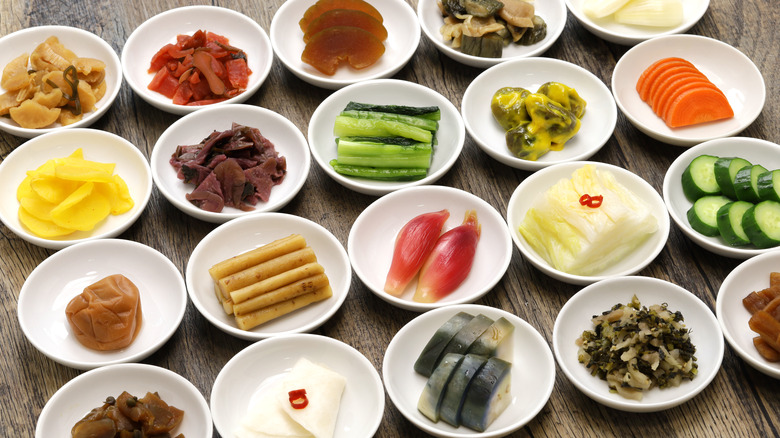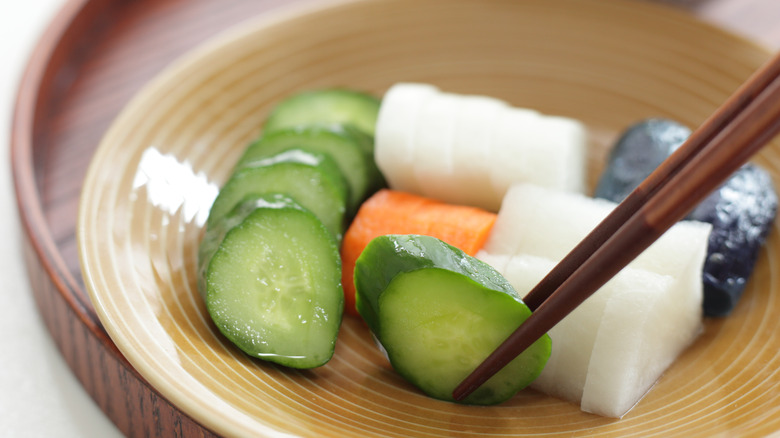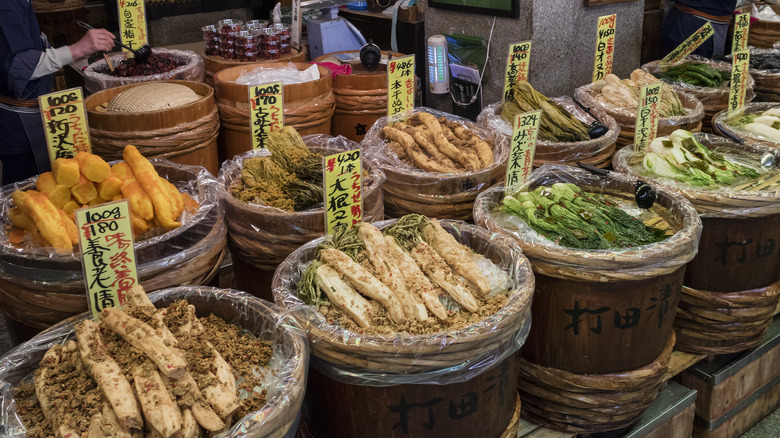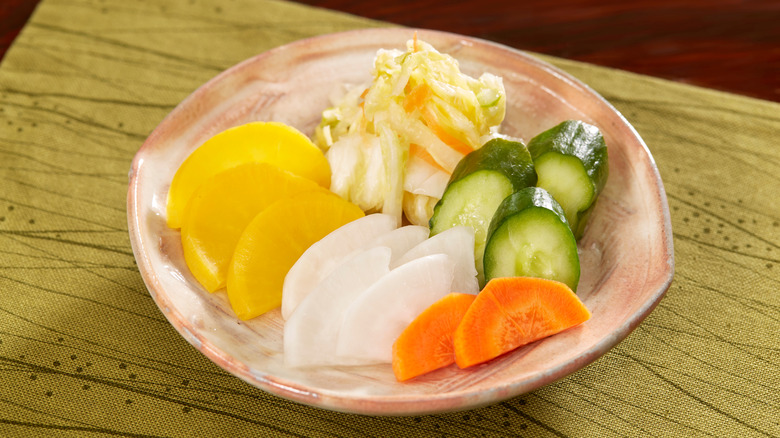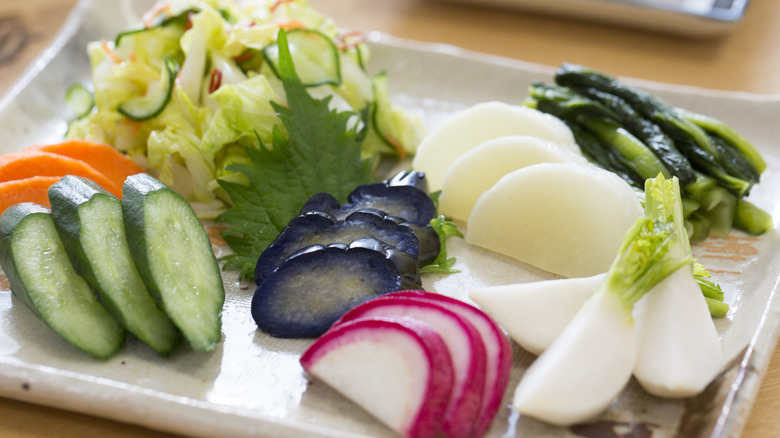Oshinko: The Pickled Japanese Veggies You Should Add To Your Plate
Pictured above is a colorful array of Japanese pickles, many made from different vegetables. Pickled items are an essential part of any plate across many cuisines. You'll find sauerkraut in Germany, curtido in El Salvador, and dill pickles in America. Pickled or fermented, a crunchy and briny side is always there to cut through excess richness or an otherwise homogeneous texture. Oshinko is a Japanese variation of this type of food — pickled ever so lightly to make a refreshing palate cleanser or a healthy side.
However, not all Japanese pickled vegetables are oshinko. In fact, it can be a confusing term, as many Japanese people often refer to the iconic yellow radish, takuan, as oshinko. Then, there is the more commonly known name for Japanese pickled vegetables, tsukemono, which is an umbrella term for vegetables pickled in salt. More often than not, you'll find a variety of the most well-known Japanese tsukemono at a sushi restaurant, and oshinko might be one among them.
What is oshinko?
Oshinko, also known as asazuke, refers to any vegetable that has been lightly pickled. Although both terms refer to the same type of dish, oshinko roughly translates to "fresh flavor" while asazuke means "shallow pickling." Oshinko is typically made with cabbage, cucumber, daikon radish, carrots, and eggplants, although most root vegetables can also be pickled in this way. Because of the nature of this light pickle, it is more perishable than other pickles and should be eaten within a few days of being prepared.
Whether it is a specialty cucumber oshinko or a medley of vegetables, oshinko is quick and easy compared to traditional pickling; it calls for a relatively short pickling time, ranging from a few hours to a few days. Nowadays, oshinko is prepared with a premade brine that you can purchase at the store, which is made up of water, sugar, salt, dashi, vinegar, and bonito flakes. The short pickling time is what gives oshinko its characteristic lightness when compared to a longer pickled or fermented vegetable, which usually turns out sour. For this reason, oshinko usually looks like the vegetable in its natural state, and you won't really be able to tell it's pickled until you take a bite.
History of oshinko
The history of oshinko, or asazuke, cannot be discussed without mentioning tsukemono. Oshinko is a specific variation of tsukemono, in that it is a Japanese pickle that has only been pickled for a short time. Tsukemono, the dominant term for pickling in Japan, simply translates to "pickled thing," but it also usually involves a deep fermentation process. Although the preservation method of pickling vegetables is common to many cultures around the globe, Japanese pickling remains unique in its processes since the salt is rinsed off post-pickling. Records show that simple salted tsukemono emerged in the 7th century, and eventually became more complex, utilizing koji-based staples of Japanese cuisine like soy sauce, sake, miso, and sake lees.
Oshinko recently became a popular alternative to the traditional tsukemono since it comes together more quickly. Of late, people have begun to make oshinko at home to get homemade pickles that aren't widely available or commercially produced. With its shorter pickling time, oshinko has much less added salt and maintains more of the natural flavors of the vegetable, making it a distinct variation of tsukemono.
Oshinko vs. Takuan
Some mistakenly refer to takuan as oshinko, since oshinko has become somewhat of a sophisticated way to refer to pickled vegetables. Takuan is an iconic yellow daikon radish found at many Japanese restaurants. Also known as danmuji in Korean cuisine, takuan is a specific type of tsukemono that requires an intense fermentation process. If prepared traditionally, the radish is first sun-dried for one to two weeks to achieve a crunchier, fibrous texture. After it is sufficiently dried, the daikon is pickled for about a month with salt, yuzu, kombu, and rice bran. The daikon radish in its natural state is white, but takuan takes on a fluorescent yellow color with the addition of turmeric or gardenia fruit (although it can range from brown to yellow).
Sushi rolls containing takuan in both the United States and Japan are called oshinko rolls, hence causing confusion between the two foods. In reality, takuan isn't really oshinko since it takes months to achieve its sweet and sour flavor and neon yellow color. Oshinko should be prepared quickly, while takuan will always require a stronger fermentation process. Another difference between oshinko and takuan is that oshinko daikon would remain white since it maintains the original appearance and flavor of the radish, as with any oshinko vegetable. Takuan has a signature sweet and tangy flavor that makes it a great side dish for a variety of meals.
How to make oshinko
Oshinko is typically prepared with a premade brine, which makes it easier to whip up right before a meal. Most oshinko liquids require that you leave the vegetables in the brine for around an hour, which leaves the vegetables slightly tart and tender. Asazuke or oshinko pickling liquids are available at Japanese grocery stores, but if you don't have one near you, you can easily make the brine yourself from scratch. Oceans Nadia made a recipe for this liquid with water, soy sauce, vinegar, salt, dashi, bonito flakes, and red pepper.
Another easy way to prepare a quick pickle is to gather your sliced vegetables and salt them in a Ziploc bag, leaving no excess air. No Recipes suggests adding about 3% of the vegetable weight in salt before adding optional seasonings like konbu or red peppers. For rapid pickling, the Ziploc should be pressed down with a weight in the refrigerator. Once the vegetables are more tender and partially translucent, they're ready to be served. If you're interested in pickling at home, oshinko is a great place to start.
